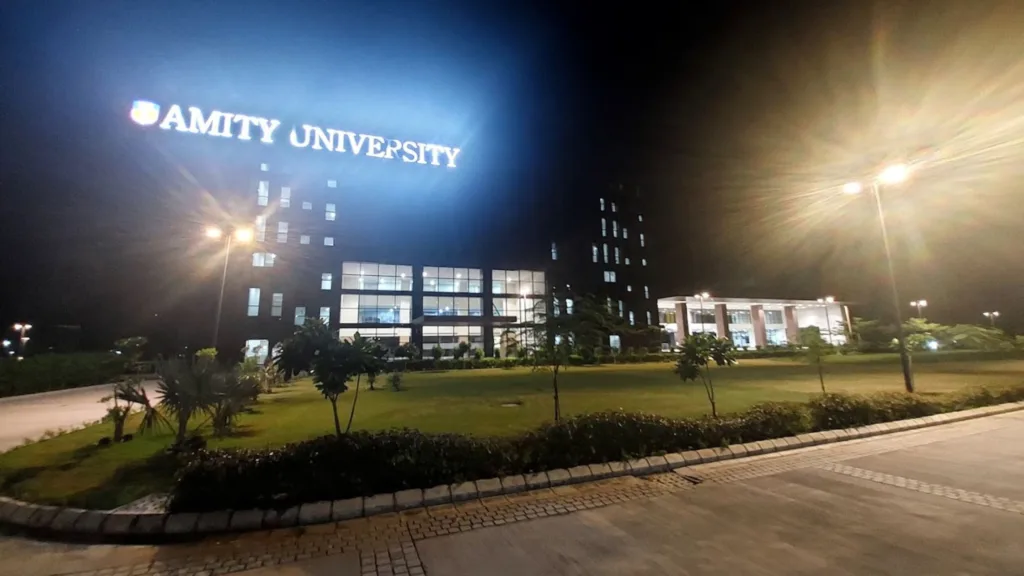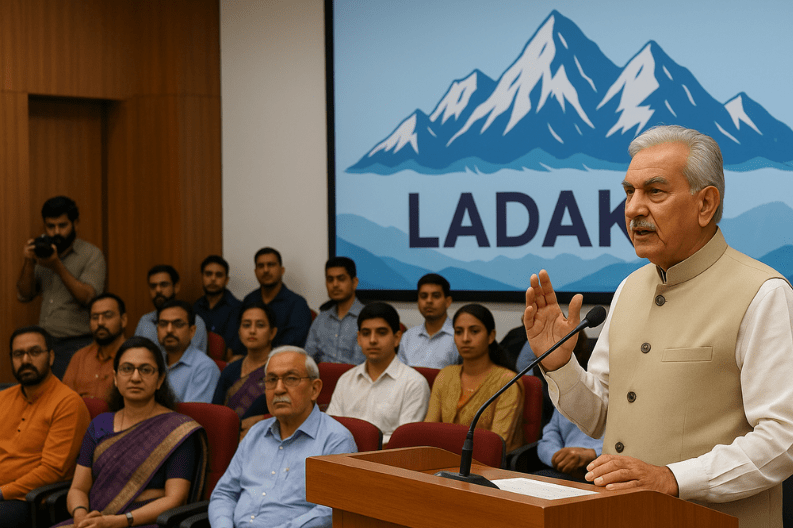Education
Amity University Mohali Programs, Admissions, & Fees 2024

Amity University is one of the leading universities in India. From providing affordable programs to premium education, this university is effortlessly showing its dedication towards converting the landscape of the education system. Amity University Mohali is performing incredibly well in matching the standards of this global education provider.
The Mohali campus of the university is the eleventh university that has been established by the group. The journey of Amity goes back forth to1986 when a visionary industrialist, Dr. Ashok K. Chauhan took a pledge to revolutionize research and education in India and all over the globe.
As 2024 is arriving, the university is all set to welcome students in different programs. This article will delve deep dive into the multiple branches of the university and provide all the latest information related to the upcoming admissions and fee structure for the programs.
Programs Offered By The Campus
The Mohali campus of Amity University offers several undergraduate and postgraduate programs. The courses offered by the university are a choice-based credit system that focuses on a structure that students find relatable to their career goals. Whether you are an enthusiast about animation, architecture, literature, or any other subject, Amity University has got you covered.
These courses offered under the programs have been reviewed timely based on industry feedback and the latest technology trends. Let us have a look at some of the courses offered by the undergraduate and postgraduate programs of this university.
Undergraduate Programs
| Department | Program | Duration |
| Animation | Game Design | B.Sc. Animation | Game Design | 3 Years |
| Architecture | Bachelor of Architecture | 5 Years |
| Biotech | B.Sc (Hons) Bioinformatics | 3 Years |
| Bachelor of Science (Bioinformatics) (Honours / Research) | 4 Years | |
| Integrated Bachelor of Technology – Master of Technology (Biotechnology) | 5 Years | |
| B.Sc ( Hons) – Biotechnology | 3 Years | |
| B.Tech (Biotechnology) | 4 years | |
| Bachelor of Science (Biotechnology) (Honours / Research) | 4 Years | |
| B.Sc.+ M.Sc (Hons) – Biotechnology – Integrated | 5 Years | |
| Chemistry | B.Sc (Hons) – Chemistry | 3 years |
| Bachelor of Science (Chemistry) (Honours / Research) | 4 Years | |
| B.Sc + M.Sc. Chemistry (Hons.) – Integrated | 5 years | |
| B.Sc Hons Computational Chemistry | 4 Years | |
| B.Sc + M.Sc. Hons Computational Chemistry – Integrated | 5 Years | |
| Commerce | B.Com – (Hons) | 3 Years |
| Bachelor of Commerce (Honours / Research) | 4 Years | |
| Computer Applications | BCA | 3 Years |
| Bachelor of Computer Applications (Honours / Research) | 4 Years | |
| Economics | BA. Hons (Economics) | 3 Years |
| Bachelor of Arts (Economics) (Honours / Research) | 4 Years | |
| BA + MA Hons (Economics) – (Integrated) | 5 Years | |
| Engineering | B.Tech (Computer Science & Engineering) | 4 Years |
| English Literature | BA Hons (English) | 3 Years |
| BA Hons (English) with Research | 4 Years | |
| BA + MA (Hons.) English (Integrated) | 5 Years | |
| Bachelor of Arts (English) (Honours / Research) | 4 Years | |
| Environment | B.Sc Environmental Science | 3 Years |
| Bachelor of Science (Environmental Science) (Honours / Research) | 4 Years | |
| B.Sc + M.Sc.Environmental Science- (Hons.)- Integrated | 5 Years | |
| Food Science | B.Sc (Hons) Food Science Technology and Processing | 3 years |
| Bachelor of Science (Food Science Technology and Processing) (Honours / Research) | 4 Years | |
| B.Sc.+ M.Sc (Hons) Food Science Technology and Processing – Integrated | 5 Years | |
| Geo-Informatics & Remote Sensing | Bachelor of Science (Geo-Informatics) (Honours / Research) | 4 Years |
| B.Sc + M.Sc.Hons Geo- Informatics Integrated | 5 Years | |
| B.Sc. Geology | 3 Years | |
| Bachelor of Science (Geology) (Honours / Research) | 4 Years | |
| B.Sc. + M.Sc. Geology (Hons.) Integrated | 5 Years | |
| Interior Design | Bachelor of Interior Design | 4 Years |
| Law | B.A., LL.B (Hons)* | 5 Years |
| Management | BBA | 3 years |
| Bachelor of Business Administration (Honours / Research) | 4 years | |
| BBA (3 Continent) | 3 Years | |
| Mathematics | B.Sc. (Hons) – Mathematics | 3 years |
| Bachelor of Science (Mathematics) (Honours / Research) | 4 Years | |
| B.Sc. + M.Sc.Mathematics (Hons.) Integrated | 5 Years | |
| Microbial Sciences | Bachelor of Science (Microbiology) (Honours / Research) | 4 Years |
| B.Sc. + M.Sc (Hons) – Microbiology Integrated | 5 Years | |
| Nutrition & Dietetics | B.Sc. (Dietetics & Applied Nutrition) | 3 Years |
| Bachelor of Science (Nutrition & Dietetics) (Honours / Research) | 3 Years | |
| Bachelor of Science (Hons) (Nutrition and Dietetics) | 3 Years | |
| Molecular Medicine & Stem Cell Research and Cancer Biology | B.Sc. (Hons) – Biochemistry | 3 Years |
| Bachelor of Science (Biochemistry) (Honours / Research) | 4 Years | |
| B.Sc.+ M.Sc. Bioinformatics (Hons.)- Integrated | 5 Years | |
| B.Sc- Human Genetics and molecular medicine | 3 Years | |
| Bachelor of Science (Human Genetics and molecular medicine) (Honours / Research) | 4 Years | |
| B.Sc + M.Sc. – Human Genetics and molecular medicine – (Hons.)- Integrated | 5 Years | |
| Physics | B.Sc. (Hons) – Physics | 3 Years |
| B.Sc Physics (Hons.) with research | 4 Years | |
| B.Sc Hons Computational Physics. | 4 years | |
| B.Sc.+ M.Sc.Hons Computational Physics Integrated | 5 Years | |
| B.Sc + M.Sc. Physics (Hons.)- Integrated | 5 Years | |
| Psychology | B.A. (Hons) – Applied Psychology | 3 Years |
| Bachelor of Arts (Psychology) (Honours / Research) | 4 Years | |
| BA+MA (Hons) – Applied Psychology – (Integrated) | 5 Years |
Post Graduate Courses
| Department | Program | Duration |
| Biotech | M.Sc Hons Bioinformatics | 2 Years |
| M.Sc (Hons) – Biotechnology | 2 Years | |
| Chemistry | M.Sc. (Hons) – Chemistry | 2 Years |
| M.Sc. (Hons) – Computational Chemistry | 2 Years | |
| Computer Applications | Master of Computer Application | 2 Years |
| Economics | M.A. (Hons) – Economics | 2 Years |
| English Literature | MA (English) | 2 Years |
| Environment | M.Sc. (Environmental Sciences) | 2 Years |
| M.SC. HONS. (ENVIRONMENTAL SCIENCES) | 2 Years | |
| Food Science | M.Sc (Hons) Food Science Technology and Processing | 2 Years |
| Geo-Informatics & Remote Sensing | M.Sc. (Hons) – Geo-Informatics | 2 Years |
| M.Sc. Geology | 2 years | |
| Law | LLB | 3 Years |
| LLM | 1 Year | |
| Management | MBA | 2 Years |
| MBA (3 Continent) | 2 Years | |
| Mathematics | M.Sc. (Hons) – Mathematics | 2 Years |
| Microbial Science | M.Sc (Hons) – Microbiology | 2 Years |
| Molecular Medicine & Stem Cell Research and Cancer Biology | M.Sc. (Hons) – Bio – Chemistry | 2 Years |
| M.Sc- Human Genetics and molecular medicine | 2 Years | |
| Physics | M.Sc. (Hons) – Physics | 2 Years |
| M.Sc. Hons Computational Physics | 2 Years | |
| Psychology | M.A. (Applied Psychology) | 2 Years |
Admissions 2024-2025
Amity University Mohali is now welcoming applications for the 2024-2025 academic year! This means if you’re dreaming of studying at a top university known for its awesome courses and vibrant campus life, then buckle up, it’s time to make your dream a reality. Here’s a quick look at what you need to know.
Doors are open for a variety of awesome programs. Whether you’re into tech like computer science or animation, creative fields like acting or filmmaking, or something else entirely, Amity Mohali has got something for you. You can browse all the available courses on their website.

Image by Amity University Mohali Punjab
Getting in is pretty straightforward. You’ll need to meet the eligibility requirements for your chosen program (think minimum marks in relevant subjects) and fill out an application form online. There might be some entrance exams or interviews depending on the course, but don’t worry, Amity will guide you through the whole process.
The deadline for applications is still a while away, so you have plenty of time to gather your paperwork and prepare. But it’s always good to get a head start, right?
Let us have a look at some of the links to begin the admission process.
- Amity Mohali website: India’s Top University Group is now in Punjab |Amity University Punjab
- Application form: Amity University – Admission Application Form
Remember, admission to Amity Mohali is competitive, so put your best foot forward and showcase your talents. If you have any questions or need help with the application process, don’t hesitate to reach out to the friendly folks at Amity. They’re there to help you every step of the way.
Fee Structure
The fees vary depending on several factors which are mentioned below.
- Your chosen program: Engineering courses tend to be on the higher side compared to, say, B.A. programs.
- Duration of the program: A five-year integrated B.Sc. + M.Sc. course will naturally cost more than a three-year B.Com.
- Additional charges: Some programs might have extra fees for things like lab equipment, studio access, or field trips.
Here’s a rough idea of the fee range for some popular programs:
- B.Tech: ₹4.8 Lakhs – ₹9.33 Lakhs per year
- B.Sc.: ₹2.7 Lakhs – ₹5.36 Lakhs per year
- M.Sc.: ₹1.6 Lakhs – ₹5.15 Lakhs per year
- BBA: ₹6.93 Lakhs – ₹10.5 Lakhs per year
- B.A.: ₹2.4 Lakhs – ₹6 Lakhs per year
Remember, these are just estimates. To get the exact fee for your chosen program, you can:
- Check the official website of Amity University in Mohali: India’s Top University Group is now in Punjab |Amity University Punjab
- Contact the admissions office: https://amity.edu/mohali/newmohali/contact.aspx
Here are some of the important tips to keep in mind.
- Scholarships and financial aid – Amity University offers various scholarships and financial aid options to help deserving students. Check their website for more information.
- Hostel and mess fees – If you plan to stay in the hostel, there will be additional charges for accommodation and meals.
- Payment options – Amity University offers various payment options, including installments and online payments.
Research Opportunities
Amity University Mohali boasts a dynamic research environment with a strong focus on cutting-edge innovation and interdisciplinary collaboration. Here’s an overview of the research opportunities available.

Image by Amity University Mohali Punjab
Research Centres
- NRDC-Amity Innovation Facilitation Centre: Supports researchers in filing patents, commercializing inventions, and collaborating with industries.
- Amity Center for Entrepreneurship Development: Fosters entrepreneurial spirit among students and faculty, providing incubation facilities and mentorship.
- Quanser Qube Laboratory: Equipped with advanced robotics and mechatronics equipment for research in automation, control systems, and intelligent machines.
- Amity Innovation and Design Centre: Promotes creativity and design thinking, facilitating research in product design, user experience, and human-computer interaction.
- Amity University- Institution Innovation Council: Encourages student participation in research and innovation, organizing workshops, hackathons, and idea competitions.
- DST – Technology Enabling Center (TEC): Focuses on research in renewable energy, clean technologies, and environmental sustainability.
- Center of Excellence for Photonics & optoelectronics: Conducts research in optical communication, lasers, and fiber optic sensors.
- Center of Excellence on Media Studies: Explores the impact of media and communication technologies on society and culture.
Research Programs
- Undergraduate Research Opportunities: Participate in ongoing faculty research projects or pursue independent research under faculty guidance.
- Postgraduate Research Programs: Master’s and Ph.D. programs with a strong research component, offering scholarships and fellowships.
- Sponsored Research Projects: Collaborate with faculty on research projects funded by government agencies, private companies, and international organizations.
How to Get Involved?
- Browse research areas: Explore the websites of research centers and departments to identify areas of interest.
- Contact faculty: Reach out to faculty members whose research aligns with your interests.
- Attend research talks and seminars: Stay updated on ongoing research activities and network with other researchers.
Additional Information
- Amity University Research website: https://amity.edu/research.aspx
- Amity Mohali Research website – https://www.amity.edu/mohali/research-centres.aspx
Remember, the specific research opportunities available will vary depending on your academic program, field of interest, and faculty expertise. Don’t hesitate to contact the relevant departments or research centers for more information and guidance.

Image by Manas Khanna
Placement Opportunities
Amity University Mohali boasts a strong track record of placements, offering its graduates access to exciting career opportunities across diverse industries. Let’s find out what you can expect.
Impressive Placement Stats
- Over 150,000 Amity alumni successfully placed in top organizations worldwide.
- 500+ leading companies, including Fortune 500 employers, visit the campus for recruitment drives.
- Amity Mohali has consistently achieved over 36,000 campus placements in recent years, even during challenging times like the pandemic.
- Top recruiters include Amazon, Capgemini, Cognizant, Dell, Accenture, Deloitte, Facebook, Google, HP, and many more.
- The highest salary package offered to an Amity alumnus stands at a remarkable Rs. 2 crore per annum.

Image by Amity University Mohali Punjab
Dedicated Placement Support
- The Amity University Mohali Career Resource Centre (CRC) plays a crucial role in facilitating placements.
- The CRC organizes pre-placement talks, workshops, and mock interviews to equip students with the necessary skills and confidence for job hunting.
- The CRC maintains close relationships with top companies, actively seeking and promoting placement opportunities for Amity graduates.
Diverse Placement Options
- Amity Mohali offers a wide range of courses across various disciplines, ensuring placement opportunities in diverse fields.
- Some of the key placement sectors include IT, engineering, management, healthcare, hospitality, media, and law.
- The university also encourages entrepreneurship and innovation, providing support for students who wish to start their own ventures.
Additional Resources
- Amity Mohali Placements website: https://www.amity.edu/placement/placement-statistics.aspx
- Amity Mohali Career Resource Centre website: https://www.amity.edu/mohali/career-resource-centre.aspx
Tips for Securing Placements
- Maintain a strong academic record.
- Acquire relevant skills and experience through projects, extracurricular activities, and internships.
- Actively participate in pre-placement activities organized by the CRC.
- Network with alumni and industry professionals.
- Prepare well for interviews and aptitude tests.
By leveraging the strong placement support system and diverse opportunities offered by Amity University Mohali, you can increase your chances of landing your dream job after graduation. Remember, your academic performance, skill development, and proactive approach will play a crucial role in your success.
But Wait! Don’t you want to know about the Infrastructure Facilities?
Amity University boasts a modern and well-equipped campus with a focus on providing students with a comfortable and conducive learning environment. Here’s a breakdown of some key infrastructure facilities:

Image by Manas Khanna
Academic Buildings
- Amphitheatre-styled classrooms: Centrally air-conditioned, equipped with Wi-Fi-enabled LCD projectors and comfortable furniture.
- Well-equipped laboratories: Dedicated labs for various disciplines like computer science, engineering, biotechnology, and healthcare, featuring modern equipment and software.
- Spacious libraries: Housing a vast collection of books, journals, e-resources, and digital databases, providing access to a wealth of information.
- Auditorium: A large and well-equipped auditorium for hosting events, conferences, and presentations.
- Faculty rooms: Dedicated spaces for faculty to prepare lectures, conduct research, and meet with students.
Other Facilities
- Hostels: On-campus hostels provide comfortable and secure accommodation for students, with options for single rooms, double rooms, and shared apartments.
- Cafeteria and food court: Offering a variety of food options to cater to diverse dietary needs and preferences.
- Sports complex: Featuring well-maintained facilities for basketball, cricket, football, badminton, and other sports, along with a gym and fitness center.
- Bank and ATM: Convenient access to financial services within the campus.
- Medical center: Providing basic medical care and support to students.
- Wi-Fi connectivity: High-speed Wi-Fi network available throughout the campus for seamless internet access.
- Ample green spaces: Lush green areas for relaxation and recreation.

Image by Amarinder Psb
Additional Points
- The campus is spread across 40 acres, providing a spacious and vibrant environment for learning and living.
- The university prioritizes sustainability and energy efficiency, implementing eco-friendly practices throughout the campus.
- The infrastructure is constantly being upgraded and expanded to meet the evolving needs of the student community.
Overall, Amity University Mohali strives to provide its students with a comprehensive and well-rounded educational experience. Modern infrastructure plays a vital role in creating a supportive and stimulating environment conducive to academic success and personal growth.
Ending Note
Amity University Mohali emerges as a compelling choice for those seeking an enriching educational experience. Its cutting-edge research opportunities, robust placement record, and modern infrastructure provide a strong foundation for academic and professional success.
From its diverse course offerings and dedicated support systems to its vibrant campus life and commitment to sustainability, Amity fosters a well-rounded environment where students can thrive. Whether your aspirations lie in research, entrepreneurship, or corporate careers, Amity University equips you with the knowledge, skills, and confidence to navigate your future with purpose and distinction.
Education
Ludhiana: Guest Faculty Finally Receive 10-Month Salary Arrears
In Ludhiana, a big win for guest faculty members happened recently.

A major relief arrived in Ludhiana after the guest faculty finally receive 10-month salary arrears, bringing joy to hundreds of teachers who had waited almost a year for their pending payments. The Guest Faculty Assistant Professors United Front celebrated this moment and appreciated the government for responding with care and speed.
Leaders of the United Front: Ravinder Singh Mansa, Gursev Singh Patiala, Paramjit Singh, and Muhammad Tanveer, thanked Higher Education Minister Harjot Singh Bains for his quick action. They said his involvement played a key role in clearing the long-pending salaries, which had caused stress for many teachers.
Guest faculty members have supported Punjab’s education system for more than twenty years. They teach in government colleges across the state and continue to guide thousands of students every year. Because of their long contribution, many believe they deserve stronger recognition and fair job security.
In 2022, the Aam Aadmi Party government increased the honorarium for guest professors. This move showed that the state understands its needs and values its service. However, when the government hired permanent professors later, new administrative steps caused delays. As a result, salaries in 25 colleges got stuck, leaving many guest faculty members under financial pressure.
Fortunately, coordinated efforts between the principal secretary and the director of higher education helped end this problem. They removed procedural hurdles and ensured payments finally reached teachers. The United Front also praised the director of higher education for honest and steady leadership during this difficult period.
Teachers across Punjab shared how delays affected their daily lives. Many said they continued teaching with dedication despite financial hardship. Ravinder Singh urged the government to regularize guest faculty services so teachers who served for decades can gain stable positions. He explained that permanent jobs would reflect the true value of their contribution to higher education.
Guest faculty members have shaped the academic journey of countless students. Because of their constant support, many colleges have been able to run smoothly even during staff shortages. Giving them job security would not only help teachers but also improve student learning.
Better treatment of educators leads to better education for everyone. When teachers feel supported, they can focus fully on teaching, guiding, and inspiring young minds. Moreover, regular pay and stable employment help create stronger academic environments.
In conclusion, clearing the pending salary dues marks a positive step for Punjab’s education sector. It shows that the government is willing to listen and respond to teachers’ concerns. Many hope this progress continues, offering more recognition and long-term support, especially after the guest faculty finally receive 10-month salary arrears.
Daily News
What Is an AI Bubble? A Deep, Clear Explanation

Artificial Intelligence (AI) has transformed from a futuristic dream into a booming global industry. Trillion-dollar valuations, skyrocketing chip demand, and rapidly expanding data centers have convinced many that AI will change the world. And in many ways, it will. But beneath the excitement, the rapid pace of investment and financial engineering has raised an important question: Are we living through an AI Bubble?
Just like the dot-com era of 1999 or the US housing bubble of 2008, an “AI Bubble” refers to a dramatic rise in valuations, investments, and expectations-far beyond what real-world fundamentals justify. When these expectations eventually confront reality, the bubble risks bursting.
This article explains what an AI bubble is, how it forms, why it matters, and how investors and industries should view it.
1. Understanding the Core Idea of a Bubble
A “bubble” is an economic condition where asset prices rise sharply because of hype, momentum, and optimism-rather than actual performance and revenue.
In the context of AI:
- Companies are investing heavily in computing power and data centers.
- Investors are pouring money into AI startups at record valuations.
- Tech giants are spending tens of billions on chips, servers, and software.
- Everyone assumes that AI will soon generate massive profits.
A bubble forms when expectations grow much faster than actual, sustainable earnings.
In other words:
A bubble is created when we assume infinite growth based on finite evidence.
2. Why AI Is Attracting Trillions of Dollars
Before calling it a bubble, we must understand why this technology attracts so much money.
AI promises:
- Faster automation
- Better productivity
- New business models
- Breakthroughs in medicine, education, finance, robotics, and more
- Massive time and cost savings for enterprises
Global companies do not want to miss out on a technological shift that could determine the next generation of winners in the economy.
There’s nothing wrong with this. Innovation requires investment.
The issue begins when these investments turn speculative, detached from realistic outcomes.
3. What Creates an AI Bubble?
a. Exponential Investment vs. Slow Monetization
AI models (LLMs, diffusion models, robotics brains) need:
- Immense GPU power
- Large data centers
- Cheap electricity
- High-bandwidth networking
- Engineering teams
- Safety teams
- Product teams
Yet, despite billions spent, AI revenue is still small. Except for a few giants like Google and Microsoft, most companies haven’t found a profitable business model.
If expenses rise faster than revenue, valuations can become artificially inflated.
b. Circular Financing
In a healthy economy, money flows like this:
Investor → Company → Revenue → Profit
But in bubbles, the flow becomes circular:
Investor → Company A → Company B → Company A
Example pattern:
Company A invests in Company B → Company B uses the funds to buy Company A’s products → Company A’s revenue goes up → valuation goes up → investors put more money.
It creates an illusion of demand-when in reality, the cash keeps cycling inside the same loop.
c. Hidden Debt and Financial Engineering
Some companies don’t want to show massive AI-related debt on their balance sheets. So they create:
- SPVs (Special Purpose Vehicles)
- Leasing structures
- Off-balance-sheet borrowing
- Vendor financing arrangements
This makes their main company appear financially healthy, even when huge risks are quietly accumulating elsewhere.
This is similar to the 2008 housing bubble, where mortgage risks were hidden inside complex derivatives.
d. GPU and Data Center Mania
An AI model isn’t just software-it lives inside expensive data centers packed with GPUs. The cost of building these facilities has exploded.
But here is the issue:
- GPUs depreciate quickly
- New generations release faster than before
- The hardware becomes obsolete
- Data center rental rates fluctuate
- Electricity and cooling costs rise
- AI demand is not guaranteed
If the business model does not justify massive capex, the investment becomes risky.
4. Fake Demand and Overreaction to Geopolitics
AI chips also became expensive because geopolitics created artificial scarcity. Restrictions on selling high-end chips to countries like China created a “shortage premium.” Companies started hoarding chips, not because they needed them immediately, but out of fear of missing out.
This artificial demand can collapse quickly once supply stabilizes.
5. AI Hype Across Non-Tech Industries
In the dot-com era, every company rushed to add “.com” to their name.
Today, something similar is happening:
- AI toothbrush
- AI washing machine
- AI refrigerator
- AI hair dryer
- AI fan
- AI cooker
- AI helmet
- AI vacuum cleaner
Most of these “AI-enabled” products do not provide any meaningful intelligence. But companies do this to attract investor money and media attention.
When hype becomes a strategy, a bubble is already forming.
6. Historical Parallels: How Bubbles Usually Work
Dot-Com Bubble (2000):
- Companies grew without revenue
- IPOs doubled on listing day
- “Internet will change everything”
- But most firms had no profits
- Bubble burst when investors demanded real cashflows
Housing Bubble (2008):
- Excessive borrowing
- Hidden risks
- Overconfidence that prices will always rise
- Collapse triggered a global recession
AI Bubble Today:
- Massive capex
- Hidden debt
- Unrealistic expectations
- Companies using AI tag for hype
- Concern that revenue may not catch up soon
7. Is AI Itself a Bubble? Absolutely Not.
Artificial intelligence is real. It is transformative, and it’s here to stay.
But the financial ecosystem around AI may be inflated.
The internet survived the 2000 crash.
Housing still exists after 2008.
But the companies built on unrealistic promises disappeared.
Similarly, AI will remain essential for the next 50+ years-but many AI businesses may not survive the financial correction.
8. When Can an AI Bubble Burst?
Predicting exact timing is impossible.
But bubbles usually burst when:
- interest rates rise
- profitability lags
- capital becomes expensive
- debt accumulates
- growth expectations fail
- competitive pressure increases
- investors look for safer opportunities
If companies cannot turn today’s multi-billion-dollar investments into sustainable revenues, correction becomes inevitable.
9. What Happens If the AI Bubble Bursts?
Short-term impact:
- Stock market correction
- Valuations of AI startups collapse
- GPU and data center prices drop
- Over-leveraged firms face bankruptcy
- Investors lose money on speculative bets
- Hiring slows across tech sectors
Long-term positive impact:
- Weak, overhyped companies disappear
- Strong products survive
- Innovation becomes more disciplined
- Infrastructure becomes cheaper
- AI becomes more accessible
- Industry stabilizes
- Real business models mature
Bubbles clean the ecosystem and leave behind only what truly works.
10. Will AI Still Grow After a Bubble? Yes-Even Faster.
A bubble does not destroy technology. It only destroys bad investments.
After the dot-com crash, the internet entered its golden period.
>After the crypto crashes, blockchain matured and became more regulated.
>After solar energy crashes, renewable companies finally became profitable.
AI will follow the same pattern:
Temporary hype → Bubble → Correction → Sustainable long-term growth
Final Thoughts
An AI Bubble forms when optimism outpaces logic, financial engineering hides risk, and everyone assumes growth will continue forever. But AI itself is not the bubble. The bubble is the money, debt, valuation, and expectation built around the technology.
AI will change the world. But the journey may include a financial reset-one that separates hype from real innovation.
True revolutions don’t collapse after a bubble.
They only get stronger.
Education
Ladakh is Becoming a Knowledge Hub of the Himalayas, Says LG Kavinder Gupta
On November 2, 2023, Lieutenant Governor Kavinder Gupta spoke at a special event in Mohali.

On November 2, 2023, Lieutenant Governor Kavinder Gupta addressed a large gathering in Mohali during the closing ceremony of the 5th Edition of the Shiksha Mahakumbh Abhiyan 2025 at the National Institute of Pharmaceutical Education and Research (NIPER). The event brought together teachers, researchers, and students from across India to discuss how education can shape the nation’s future. The theme, “From Classroom to Society – Building a Healthier World through Education,” perfectly matched the idea that Ladakh is becoming a knowledge hub of the Himalayas.
During his speech, Gupta spoke about India’s proud tradition of learning and self-reliance. He said, “Our rulers may have been enslaved, but the soul of Bharat never accepted subjugation.” His words reminded the audience that knowledge has always been India’s strength, even during difficult times.
He praised Prime Minister Narendra Modi’s leadership in advancing education through the National Education Policy (NEP 2020). Gupta emphasized that India’s education system is now moving beyond textbooks. “Under the Prime Minister’s leadership, India’s education system has evolved to include technology, skills, and values,” he said. According to him, this approach creates responsible citizens who can serve the country’s development.
Gupta also acknowledged Vidya Bharati’s role in promoting discipline, cultural awareness, and national pride among students. “Education must not only enlighten the mind but also awaken the moral conscience of the nation,” he said. He encouraged teachers to help students connect classroom lessons to real-life community goals.
He discussed how education has strengthened social unity in Jammu & Kashmir and Ladakh. “There was a time when misguided voices tried to divide people, but now education has united them,” Gupta said. He added that learning has replaced fear with hope and inspired youth to aim higher.
Speaking about Ladakh’s achievements, Gupta highlighted that the region has made remarkable progress in literacy. “Inspired by Prime Minister Modi’s vision of Viksit Bharat 2047, Ladakh has made education the center of its growth model,” he said. The Union Territory is now a Fully Functionally Literate Region under the ULLAS (New India Literacy Programme) with a literacy rate of 97%, far above the national average.
The establishment of the University of Ladakh has been a game-changer. It has become a center for innovation and cross-cultural learning. Additionally, more than 150 Smart Classrooms and 171 ICT Labs have been set up to improve digital education in schools. The construction of 36 PM SHRI Schools will soon add modern facilities to further raise educational standards.
Before the closing ceremony, Prof. (Dr.) Thakur S.K.R, Director of DHE, presented a detailed report summarizing discussions and future plans for the Shiksha Mahakumbh. Many teachers and students were honored for their excellence in education. Dilaram Chauhan, General Secretary of Vidya Bharati (North Zone), delivered a keynote address emphasizing the importance of collaboration between schools and society.
Bal Kishan, Joint Organising Secretary of Vidya Bharati, North Zone, described the event as “a living example of cooperation between schools, universities, and communities.” This partnership shows how unity in education can lead to national progress.
The activities and ideas shared during the Shiksha Mahakumbh show a firm commitment to transforming education in the Himalayan region. They highlight how a focus on learning can build a peaceful, inclusive, and strong society.
With steady development and visionary leadership, Ladakh is becoming a knowledge hub of the Himalayas. The region’s success reflects India’s growing emphasis on education, innovation, and values that will guide the next generation toward a brighter future.
-

 Entertainment2 years ago
Entertainment2 years agoTop 15 Punjabi Models – Male and Female List
-

 City Guide2 years ago
City Guide2 years ago3B2 Mohali Market Shops: Discover 44 Hidden Gems
-

 Entertainment2 years ago
Entertainment2 years agoTop 11 Punjabi Comedians of All Time
-

 Jobs4 years ago
Jobs4 years agoTop 20 IT Companies in Mohali
-

 Food4 years ago
Food4 years ago11 Best Restaurants in Mohali You Must Visit
-

 Property2 years ago
Property2 years agoWho Lives In Homeland Mohali: Punjabi Celebrities, Business People…
-

 Food3 years ago
Food3 years agoTop 15 Cafes in Mohali you must visit
-

 Education2 years ago
Education2 years ago10 Famous Punjabi Writers With A Great Impact On The Literary World
